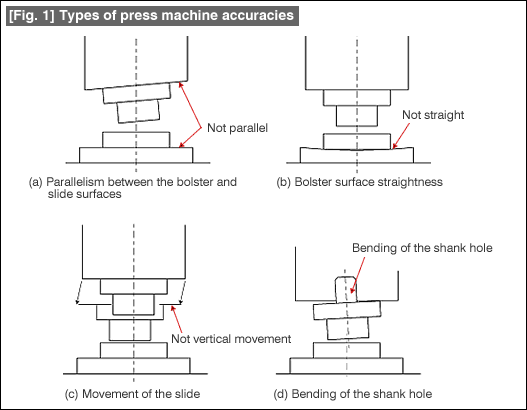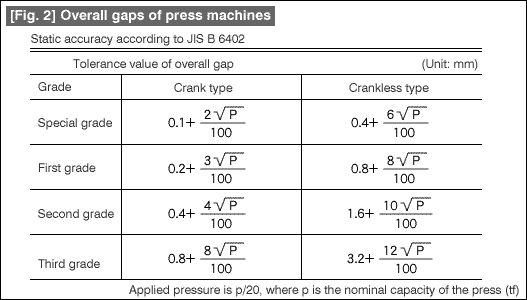The accuracy of press machines not only has adverse effects on the press formed products, but also shortens the life of the dies. The accuracy of press machines is of two types, namely, static accuracy which is the accuracy in the state in which no load is applied, and the dynamic accuracy which is the accuracy in the condition in which the products are being formed. Dynamic accuracy has not been stipulated in JIS. Therefore, the accuracy used at the time of purchasing a press machine is only the static accuracy. Dynamic accuracy is original to the manufacturer and there are fine differences between different manufacturers. The main static accuracies are the following.
Fig. 1 shows the different types of press machine accuracies.

a. Parallelism between the bolster and slide surface
This is the parallelism between the top surface of the bolster plate and the bottom surface of the slide. Even if the slide is carrying out truly vertical movement, if the parallelism of this part is poor, it not only affects the bending angle and the suppression of wrinkles in drawing, but also reduces the life of the die.
b. Straightness of the bolster surface
Since the bottom surface of the bottom die and the surface of the bolster plate are not in close contact, the pressing at the bottom dead center does not stabilize.
c. Defective movement of the slide
Although the slide is only expected to carry out vertical movement, sometimes, it may move at an inclination or can move in the form of the letter 8 in the vertical direction. If such movements are made, the wearing of the guide post is speeded up. Of course, the product quality is also affected.
d. Bending the shank hole
In a small die, although sometimes the top die is installed using the shank hole of the slide, if the hole is not drilled vertically in the bottom surface of the slide, the die will be installed at an angle leading to the same problems as in (a) above.
e. General gap
Various parts are moving in order to make the slide move up and down. There are very small gaps between the moving parts. This gap changes when a pressure is applied thereby causing the bottom dead center to be disturbed. When no pressure is applied, the parts become relaxed returning the gaps to the original larger values and hence large movements can be made. Such a deformation is called the overall gap. The amount of displacement is investigated when the slide is pushed up with a force equal to 5% of the nominal force. This JIS standard is shown in Fig. 2.
